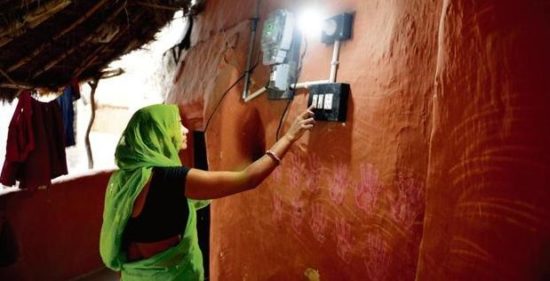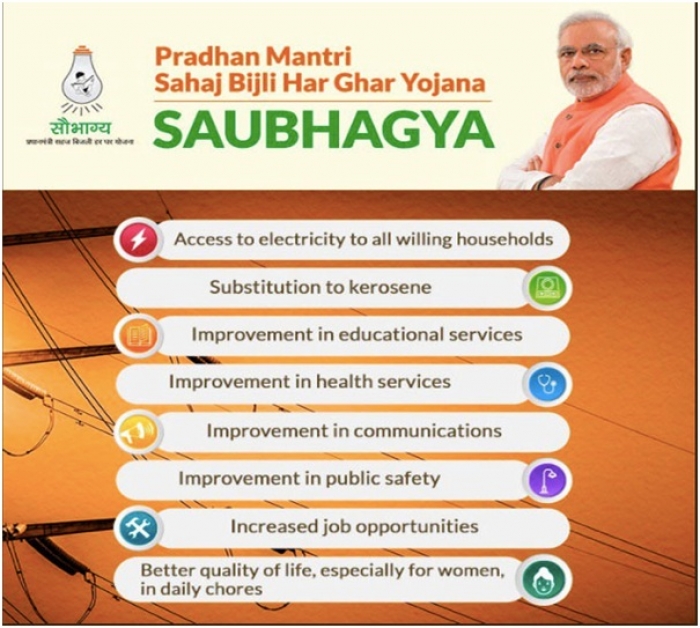Saubhagya Scheme – In Pursuit of 100% Electrification

The ambitious Pradhan Mantri Sahaj Bijli Har Ghar Yojana, better known as “Saubhagya” scheme, for universal household electrification is all set to achieve its goal soon with only about 28,000 households left to be electrified all over the country. On the other hand, criticisms have been pouring across the country regarding the scheme’s inability to solve some of the grey areas in the power sector.
What is Saubhagya Scheme and What are its salient features?
- The Saubhagya Scheme was launched in September 2017.
- It aims at achieving universal household electrification in all parts of the country.
- The objective is to provide last mile connectivity and electricity connections to all remaining un-electrified households in rural as well as urban areas of the country. The scope of the scheme are as follows:
- Providing last mile connectivity and electricity connections to all un-electrified households in rural areas.
- Providing Solar Photovoltaic (SPV) based standalone system for un-electrified households located in remote and inaccessible villages/habitations, where grid extension is not feasible or cost effective.
- Providing last mile connectivity and electricity connections to all remaining economically poor un-electrified households in urban areas. Non-poor urban households are excluded from this scheme.
- Rural Electrification Corporation (REC) has been made the nodal agency for the Saubhagya Scheme.
- Rural Electrification Corporation Limited (REC) is a leading public Infrastructure Finance Company in India’s power sector.
- It is functioning under the purview of the Ministry of Power – Government of India.
- It is headquartered in New Delhi.
- The company finances and promotes rural electrification projects across India.
- The company provides loans to Central/ State Sector Power Utilities, State Electricity Boards, Rural Electric Cooperatives, NGOs and Private Power Developers.
- All DISCOMs (power distribution companies) including private sector discoms, state power departments, and RE cooperative societies shall be eligible for financial assistance under the scheme in line with Deen Dayal Upadhyaya Gram Jyoti Yojana (DDUGJY).
- Beneficiary households would be identified using SECC 2011 data. But un-electrified households not covered under SECC data would also be provided electricity connections under the scheme on Rs. 500 payment which shall be recovered by DISCOMs in 10 installments through electricity bill.
- It is being funded to the extent of 60% by Central grants, 30% by bank loans and 10% by states.
What is the need for Saubhagya Scheme?
- Village electrification programme such as Deen Dayal Upadhyay Gram Jyoti Yojana, launched in July 2015 revealed that a huge number of households are yet to be provided access to electricity.
- The Ujwal DISCOM Assurance Yojana (UDAY scheme) has failed to make enough difference regarding the fundamental problems in the power sector as follows:
- The power generation utilities in India remain highly under-utilized, and investments in the sector are drastically falling.
- The plant load factor (PLF), an indicator of capacity utilization of power generation units, has dropped consistently over the decade.
What is the significance of the scheme?
- Resolve the NPA problem: The deeply troubled power sector accounts for almost 1/10th of all bank loans in India. The scheme will resolve the issue of NPA in the power sector as the power discoms who are in financial distress may be able to recover some of their costs through the new household connections and added demand.
- Reduce health hazards: The use of kerosene for lighting purposes could be curbed = reduce indoor air pollution thereby saving people from health hazards.
- Reduce government expenditure: Replacing kerosene with electricity would also reduce annual subsidy on kerosene and would also help reduce the import of petroleum products.
- Improve health services: Electricity access would help in creating effective and modern health services in all parts of the country.
- Increase in social and economic activities: Lighting after the sunset also provides a sense of increased personal safety particularly for women = increase in social and economic activities after sunset.
- Boost educational services: Electricity access will boost education services across all areas and quality lighting after sunset would help children spend more on studies and move ahead further in prospective careers. Household electrification also enhances the possibility that women would study and earn income.
- Improve agricultural productivity: Farmers can access information about new and improved agricultural techniques, agro machinery, quality seeds etc. = considerable increase in agricultural production = increase in farmer income.
- Generate employment: Implementation of the scheme would itself lead to employment creation considering the need for semi-skilled/skilled manpower for execution of works of household electrification under the scheme.
What are the concerns?
- Neglecting rural enterprises: Despite achieving near 100% electrification of households, the saubhagya scheme has been criticized for not being able to cover a sizeable chunk of commercial rural enterprises which are still cut off from grid-connected power as the scheme’s focus is primarily on rural households. Enterprises that have better access to reliable electricity can increase income for entrepreneurs and creating prosperity within the communities.
- Payment of bills: It expects the poor to pay the bills without providing any subsidy to ease their burden.
- Expecting poor households to bear the recurring burden of bills as per the prevailing tariff of DISCOMs is unimaginable.
- The government doesn’t consider the fact that the inability to pay the electricity bill is a big challenge for the poor in some states.
- Efficiency: Even if 100% of households are electrified in the villages, there is no promise of minimum hours of supply as the scheme doesn’t address structural issues that plague the broken power sector. There is a power shortage which results in scheduled and unscheduled load shedding, often up to 10 hours or more.
- Illegal connections: It fails to consider illegal connections taken by households which find it difficult to afford legal access to power.
Electricity access definitely has positive effect on quality of life of people in all aspects of daily household chores and human development. The Saubhagya scheme is a significant initiative as it touches different aspects of human life – health, education and employment. Its successful implementation is the key to creating smart villages, ensuring energy security and improving the lives of people living in remote and inaccessible areas.
If you like this post, please share your feedback in the comments section below so that we will upload more posts like this.



